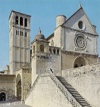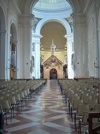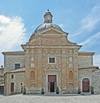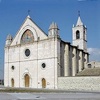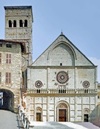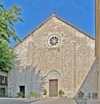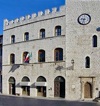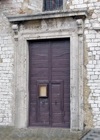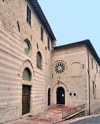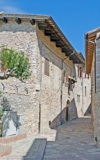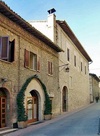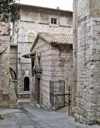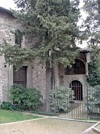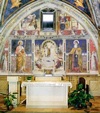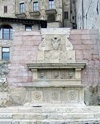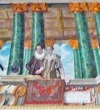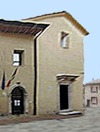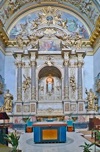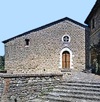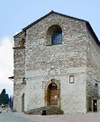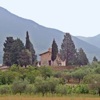

Franciscan Monuments
For many visitors, Assisi is the city of St Francis. The following monuments are associated with him and/or with St Clare.
St Francis cared for lepers at San Lazzaro in Arce, later Santa Maria Maddalena, which is close to the site of the hermitages at Rivotorto and at the Portiuncula (see below).
St Francis had a vision before a crucifix here in 1205, which marked an important point in his conversion. He subsequently spent several months restoring the church. St Clare established a small religious community here in 1211 that became known as the Order of San Damiano. St Francis wrote the “Canticle to Brother Sun” here during the early stages of his final illness. When he died in 1226, his body was brought to St Clare here, en route for its temporary burial in Assisi. St Clare died here in 1253. The he nuns left soon after to be close to her relics in Santa Chiara (below) and San Damiano passed to the Franciscans and transferred to the Observant Franciscans in 1473. The community was suppressed in 1867, but George Robinson, Lord Ripon bought the complex from the Italian state and gave it back to the Franciscans
in 1894.
Pope Gregory IX commissioned the magnificent double church, the “caput et mater” (literally head and mother) of the Franciscan Order to house the relics of St Francis, which were translated here in 1230. The upper and lower churches house some to some of the finest Italian art of the late 13th and early 14th centuries. The crypt is also open for veneration of sarcophagus of St Francis.
This was the site of the ancient church of San Giorgio, which had associations with St Francis:
-
• he attended school here as a child;
-
• his relics were housed here in 1226-30; and
-
• he was canonised here in 1228.
The body of St Clare was brought here from San Damiano (above) in 1253, and the nuns of San Damiano established a new nunnery here soon after. The relics of St Clare re-discovered under the high altar in 1850. The nunnery remains one of the most important in Italy.
The Abbot of San Benedetto (below) gave the land on this site on Mount Subasio to St Francis in ca. 1215. It became a Franciscan hermitage and was placed under the control of Blessed Paoluccio de' Trinci in1374.
This church was built to enclose the chapel known as the Portiuncula (illustrated here under the crossing), which Abbot of San Benedetto (below) gave to St Francis in 1207. St Francis had a vision here that led to the granting of the Portiuncula Indulgence, which still attracts large numbers of pilgrims on the annual Festa del Perdono. St Francis died in the hut that acted as the infirmary of the friars’ hermitage here (now the Cappella del Transito) in 1226. This became the site of an Observant Franciscan convent. Galeazzo Alessi designed the present church, which contains an interesting collection of Mannerist art.
In 1615, Brother Alessandro di Trejo, the Vicar General of the Observant Franciscans, acquired the supposed site of the house in which St Francis was born. He arranged the finance for a new church here, which was consecrated in 1691.
A church was built on the presumed site of a hovel used by St Francis and his early followers in 1600-40. The present neo-Gothic church was built after its predecessor was destroyed in an earthquake.
Other Important Monuments in Assisi
A "parva basilica" (small basilica) that was documented on this site in 1050 had been built many centuries earlier to house the relics of St Rufinus. Bishop Ugone built a new church here that replaced Santa Maria Maggiore (below) as the duomo of Assisi in 1035. Its apse survives under present church and forms part of Museo Diocesano. Work started on the apse of present church in 1140 and it was consecrated in 1253. The interior remodelled to a design by Galeazzo Alessi in 1571 and the interior further remodelled 1848. Fortunately, the fine 12th century facade survives.
This church, which was built close to the Roman city walls, was the original duomo of Assisi. It was first documented in 963, but crypt under the apse probably dates to the 9th or 10th century. San Rufino (above) replaced Santa Maria Maggiore as the duomo in ca. 1035. Santa Maria Maggiore was largely rebuilt in 1162-1216. It was badly damaged in an earthquake in 1832; the ceiling of the nave and the right aisle were destroyed, along with many of its frescoes and its stained glass. However, a number of interesting frescoes survive.
This Benedictine abbey was first documented in 1029. The crypt of present church probably dates to around this time. The relics of St Victorinus were translated here at an unknown date. Pope Innocent IV consecrated church after its rebuilding in 1253 and its facade was completed in 1268. Pope Gregory XIII expelled the monks in 1577, and San Pietro became a parish church until 1613, when Pope Paul V gave it to San Pietro, Perugia, which belonged to the the Cassinese Congregation. This community was suppressed in 1866 but returned in ca. 1918.
This Benedictine abbey on Mount Subasio was at centre of political life of Assisi in middle ages. Its monks built church of San Paolo (below) in Assisi 1041-71. The abbey made two important donations in the 13th century:
-
•Abbot Tebaldo gave the Portiuncula (above) to St Francis in 1207; and
-
•Abbot Maccabeo transferred the church of San Donato (below) to the newly-formed Commune for use as the Palazzo dei Consoli in 1212.
Its strategic position led to its partial destruction in the civil disturbances of 1339 , at which point the monks moved to San Paolo. The abbey passed to the Canons of San Giorgio in Alga in 1468 and was restored in 1601. The Congregation of San Giorgio in Alga suppressed in 1652 and the complex passed to a series of commendatory abbots. It was sold into private ownership in 1860 and bought by the Abbazia di San Pietro (above) in 1945. crypt of an earlier church (8th or 10th century) was discovered in 1945-52. (Not open for visits as at January 2008).
This temple, which was probably built in the forum of Roman Asisium soon after the Perusine Wars (41 BC), represents the most complete survival of its kind after the Pantheon in Rome. In 1212, it was documented as church of San Donato, which the Abbazia di San Benedetto (above) sold to the Commune. The ground floor reopened as church of SS Donato, Sebastiano e Bernardino da Siena in 1456, but the rest of the space continued to function as a public palace until ca. 1471. The building was restored and reopened as church of Santa Maria sopra Minerva
in 1539. The French archaeologist Charles Victor Famin excavated the forum below and in front of the temple in 1836; the excavated area now forms part of Museo Civico. The interior still functions as the church of Santa Maria sopra Minerva.
This page describes:
-
•Palazzo dei Consoli (12th century), the first public palace, which was near the Duomo;
-
•the ex-Church of San Donato (Temple of Minerva - above), which was used by the commune from 1212;
-
•Torre del Popolo (ca. 1274-1305);
-
•Palazzo del Capitano del Popolo (ca. 1275-82), illustrated here;
-
•Palazzi dei Priori (1295 - 1471); and
-
•Palazzo del Governatore (14th century)
This page describes:
-
•Rocca Maggiore (illustrated here); and
-
•Rocca Minore.
The Emperor Charlemagne probably built the first fortresses on these sites commanding the city after he sacked it in 773. The citizens of Assisi destroyed them when they declared a free commune in 1198. Cardinal Albornoz rebuilt them as part of the refortification of Assisi after he had regained it for the papacy. Ugolino di Montemarte is generally credited with the design.
Rocca Maggiore is open for visits; Rocca Minore was still in restoration at 2011.
Nunneries of Assisi
The important nunnery of Santa Chiara and the ex-nunnery of San Damiano are described above.
A community of Benedictine nuns from Santa Caterina di Picaiai, outside Assisi, moved here in 1278. It was suppressed in 1595, at which point the Confraternita di SS Giacomo e Antonio (above) moved here from Sant' Antonio Abate (see “Smaller Churches” below). Excavations (still in progress at January 2009) have brought to light important remains of the Roman amphitheatre (below).
Ubertino di Guittone of Assisi paid for a church to be built here in 1088, as part of his penance for murder, and gave it to the Abbazia di Farfa. It passed to the canons of San Rufino in ca. 1260. The Benedictine nuns of San Donato di Flebulle at Colcaprile, outside Assisi, who moved to a site next to San Giacomo in 1323, were given the church itself in 1458. This community was suppressed in 1860, and the nuns subsequently moved to the Monastero delle Benedettine di San Giuseppe (below). The complex passed to the Suore Francescane Angeline in 1902. The church open for visits, by appointment.
This nunnery was formed from two separate communities, each of which was initially established outside Assisi:
-
•a community of female penitents that originally settled at the Eremo di Sant Apollinare then established the Monastero di Sant Apollinare here in 1264; and
-
•the Benedictine nuns from San Paolo delle Abbadesse, moved to the adjacent site in 1330;
San Paolo was suppressed in 1442 because of the nuns’ poor behaviour, and its property was transferred to Sant’ Apollinare. This community was suppressed in 1866. The nuns from San Giacomo de Murorupto (above) bought this complex in 1897, at which point it became the Monastero delle Benedettine di San Giuseppe. It is possible to see the two churches by appointment, and the nunnery also offers accommodation.
A community of female Franciscan tertiaries that was affiliated to Sant’ Anna, Foligno built a nunnery here in 1447-51. The nuns from Sant’ Antonio da Padova (below) moved here in ca. 1573. The present church, which has its façade in Via Antonio Cristofani, was consecrated as SS Quirico e Julitta in 1600and renovated in 1899. The nuns, who joined the First Order of Poor Clares in 1931, hid many Jews threatened with deportation during the German occupation of Assisi
1943-4. Roman remains found on the site were for a long time thought to relate to a temple, but they have recently been identified as those of the Roman baths (below).
This page describes some of the smaller nunneries in Assisi, many of which were originally established outside the city:
-
•Sant' Andrea (13th century), illustrated here;
-
•Sant' Angelo in Panzo (1270);
-
•Monastero della Benedetta (15th century);
-
•Santa Coletta (1909-26);
-
•Santa Croce (1901); and
-
•San Nicolò dell’ Orto (14th century ?).
Oratories and Confraternities of Assisi
-
• Confraternita di San Gregorio;
-
• Confraternita di Santo Stefano, whose oratory is illustrated here;
-
• Confraternita di San Lorenzo;
-
• Confraternita di SS Giacomo e Antonio Abate;
-
• Confraternita di Sant' Antonino;
-
• Confraternita di Santa Chiara;
-
• Confraternita di San Francesco;
-
• Confraternita di San Pietro;
-
• Confraternita di San Rufinuccio;
-
• Confraternita di Santa Maria del Vescovado; and
-
• Confraternita di San Vitale
Some of their surviving oratories have separate pages:
This oratory was built after merger of two originally separate organisations:
-
•the Confraternita di Santa Maria del Vescovado; and
-
•the Confraternita di San Biaggio;
This merged confraternity was suppressed in 1772, and the oratory passed to the Confraternita dei SS Crispino e Crispiniano (Shoemakers’ Guild). It is now part of a hotel.
Gentile di Bernardo Fiumi gave land next to his family residence to the Confraternita di San Francesco in 1428 for the present oratory. It is now used for Anglican services on one Sunday of each month.
The Confraternita di San Gregorio, which was probably the first to be formed in Assisi, moved to this oratory in 1325. The confraternity was suppressed in 1772. The ex-oratory sometimes used for concerts.
The Confraternita di San Lorenzo, which owned this oratory, was first recorded in 1329 and suppressed in 1772. Mary Lowell Berkley, American wife of Lord Berkley, bought the oratory (which became known as Villa Berkley) in 1933. An important Umbrian inscription was found in garden in 1938.
The Confraternita di SS Antonio e Giacomo owned this oratory and the Ospedale dei Pellegrini next to it. The hospice was demolished in 1883. The Suore Francescane Missionarie del Giglio, who built the neo-Romanesque building that replaced it, still use the oratory, which contains important frescoes.
This oratory dedicated to St Rufinus of Arce, which belonged to the Confraternita di San Rufinuccio, was first documented in 1348.
Other Monuments in Assisi
This was originally the site of the palace of the canons who officiated at the adjacent San Rufino (above), which was first documented in 1029. The canons shared it with bishops of Assisi in 1035-82. Recent excavations under the present building have revealed parts of the original palace, including the remains of a cloister. The excavated space now houses the Museo Diocesano.
This page describes:
-
•Fontanella del Lione (1559);
-
•Fonte Marcella (1556-7), illustrated here;
-
•Fonti di Moiano (restored in 1294);
-
•Fonte Oliviera (1570);
-
•Fonte di Perlici (1294);
-
•Fonte di Piazza del Comune (1762);
-
•Fonte di San Nicolò (date?);
-
•Fontana di San Rufino (1532); and
-
•Fontana di Via Portica (12th century).
Assisi was confined by its Roman walls (below) until ca. 1260, when work began on a new circuit. Still another was begun in 1316, in order to encompass the new suburbs of Assisi. This work was soon interrupted, when city plunged into warfare, papal interdict and plague. The outer walls probably took on its present form in 1362-5, when Cardinal Albornoz regained Assisi for the papacy. The completed circuit had eight gates and almost doubled the size of the walled city.
The Ospedale della Misericordia, which was one of the first public hospitals in Italy, was established here in 1267 by two of the guilds of Assisi.
The Monte Frumentario which lent seed to poor farmers, was established in Via San Rufino by Cardinal Antonio Barberini in 1634. Bishop Ottavio Ringhieri transferred it to this location in 1746.
Palazzo Giacobetti Vallemani (ca. 1600)
This page describes:
-
•Palazzo Bartocci Fontana (16th century);
-
•Palazzo Bonacquisti (16th century), illustrated here;
-
•Palazzo Bernabei (1646);
-
•Palazzo del Cardinale (1449);
-
•Palazzo Fiumi-Roncalli (17th century;
-
•Palazzetto Vannola (17th century); and
-
•Villa Gualdi (ca. 1873).
The bishops’ residence was documented next to Santa Maria Maggiore (above)from 10th century. It moved to the site of the Casa dei Canonici (above), next to San Rufino in 1035 but returned to this site in 1082 - bishops’ residence returned to this site. St Francis famously relinquished his possessions before Bishop Guido I outside this palace in ca. 1208, and he stayed here before he was carried to the Portiuncula (above) to die, in 1226. The present palace on the site was built in 1612 and extended in 1653-6.
This page also describes the Seminario Vescovile, which was established in the 1590s.
This page describes:
-
•the site of the amphitheatre (early 1st century AD), illustrated here;
-
•the baths (2nd century AD) that have been excavated at San Quirico (below);
-
•the cistern (2nd century BC ) under the campanile of San Rufino (above);
-
•the domus (1st century BC), excavated under at Palazzo Giampè;
-
•the so-called House of Propertius (1st century AD), excavated under Santa Maria Maggiore (above);
-
•the mausoleum (early 1st century AD) in Via San Rufino; and
-
•what might be the remains of the theatre (1st century AD), in Via San Rufino.
Roman Walls (2nd century BC ?)
A community of female Franciscan tertiaries was established here 1490, but the nuns forced to move to San Quirico (above) in 1573. The present church was built in 1607 and passed to the Third Order Regular of St Francis in 1612. This community also acquired the church of Santa Maria sopra Minerva (below) in 1613 and initially maintained both establishments. It became concentrated at Sant’ Antonio in 1758 and was suppressed in 1860. The church and convent adapted as a school in 1990.
Santa Maria sopra Minerva (1527-39)
-
•San Donato, when the temple was first adapted as the church, probably in the 12th century; and
-
•SS Donato, Sebastiano e Bernardino, when it re-opened as a church in 1456, after having been put to civic use in ca. 1212.
The church took on its present form after a restoration in 1527-39, and was then re-dedicated to the Virgin. In 1613, passed to the Franciscan Third Order, whose main convent was at Sant’ Antonio da Padova (above). They sold it to the Oratorian Fathers in 1758. This community was suppressed in 1810, and the complex passed to the secular clergy. It passed back to the Franciscan Third Order
in 1918.
When the Bianchi march (a penitential procession from Provence to Rome) arrived in Assisi in 1399, the Virgin apparently appeared to a boy in an olive grove on this site outside outside Porta Nuova, and exhorted him to rouse the citizens to join it. This church was built on the spot soon after, and the feast of the “Madonna dell’ Olivo” was celebrated for centuries in Assisi. The church was restored in 1964 but subsequently abandoned.
The friars of San Francesco in Assisi had a small hermitage here from the 13th century. It now belongs to the Comunità Adveniat Santa Maria in Arce. The church, which can be visited, contains a number of interesting works of art.
This church was built on foundations provided by a Roman terrace, probably soon after the Carolingian sack of Assisi in 773. It was first documented in 1198. It is now deconsecrated and houses an exhibition of modern works of art by Guido Dettoni della Grazia.
This church was first documented in 1097. St Francis prayed here, soon after his conversion (in ca. 1207): he opened the Bible at random three times and each time it opened at a verse in which Christ told his followers to embrace a life of poverty. The church was badly damaged in an earthquake in 1832 and deconsecrated in 1848. It was subsequently used as a barracks and then demolished demolished in to make way for the Palazzo delle Poste (1927). Surviving crypt now houses the Museo Civico.
The monks of the Abbazia di San Benedetto (above) built this church and adjacent priory. Pope Innocent IV consecrated (or perhaps re-consecrated) the church in 1253. The monks all moved here in when the Abbazia di San Benedetto was damaged by fighting in 1339. The church (along with the abbey) passed to Canons of San Giorgio in Alga in 1481. When the Congregation of of San Giorgio in Alga suppressed in 1652, the complex passed to the canons of San Rufino. Much of the canonica subsequently demolished. The church now belongs to the Confraternita di San Rufino and is occasionally open for worship.
This tiny Romanesque church documented as a parish church in 1166. According to tradition, its bells spontaneously rang out when St Francis died in 1226. The interior restored in 1963.
Santissima Trinità (12th century)
This page describes the following small churches:
-
•Sant’ Antonio Abate (12th century);
-
•San Bernardino (1472);
-
•San Feliciano [date ???], illustrated here;
-
•San Francesco Piccolino (13th century);
-
•Santa Margherita (13th century);
-
•Santa Maria della Immacolata Concezione (19th century);
-
•San Rufino in Arce (late 12th century); and
-
•San Salvatore delle Pareti (12th century).




